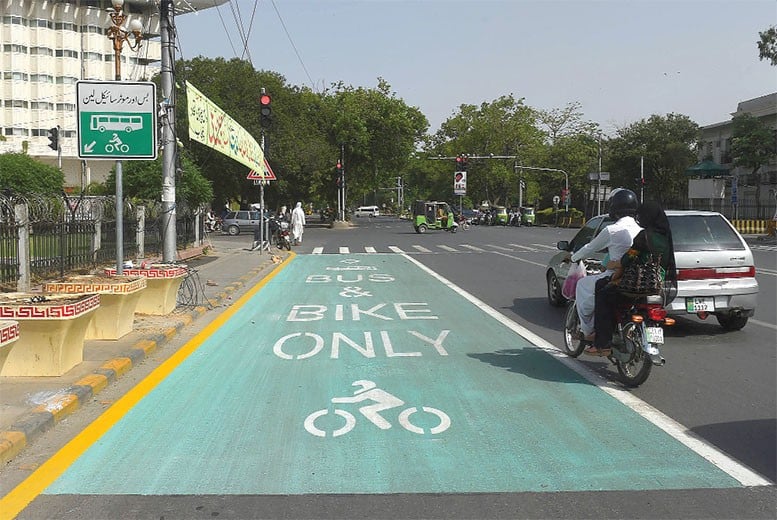
A separate lane for motorcyclists has been introduced in patches on The Mall. Does our road design support this initiative?

Commuters on The Mall can now see a lane painted in green, near Faisal Chowk and the Punjab Assembly building. It is a lane on the far left which has been reserved recently for slow moving traffic that comprises rickshaws, motorcycles and buses. This has been done for the first time, though a proposal to this effect has always been there.
The idea behind the move is to stop the zig-zag movement of commuters -- especially that of motorcyclists -- which obstructs the traffic and even results in accidents.
The said lane, named ‘Green Lane,’ has been introduced on the advice of the Punjab Safe Cities’ Authority (PSCA), initially on The Mall. The plan is to introduce it on Canal Road in the next phase and, later on, in areas where the road design allows such a provision.
It’s not a continuous line -- it is marked for 20 metres after every 60 metres on the road starting from Faisal Chowk and ending at the point where it meets the Lahore Canal. So, one can see it for 20 metres and then again after one has travelled 6o metres, for another 20 metres. The distances between every two stretches of Green Lane are free for all corridors.
No doubt it’s a much-awaited measure aimed at ensuring a smooth flow of traffic on the city roads. When everyone remains within their dedicated lanes, chances of obstruction and traffic jams will be fewer.
But the question here is that is it possible to extend this project to the entire city where road designs are faulty at most places and the width of roads smaller than desired. At several locations, encroachments and illegal parking lots have narrowed the road spaces making it difficult to find a lane spared for slow moving traffic.
Moeen Ahmed, a college student, wonders how it will be possible to have a Green Lane along the Canal Road which is ill-designed. He says the underpasses along the road are not aligned -- some fall on the right side and some on the left. "Here, you can’t escape changing lanes."
Ahmed also complains that the motorcyclists will find themselves in a difficult position if made to share lanes with buses.
The traffic department has similar concerns. Sources in the department say that dedicating a lane for motorcyclists is not possible in parts where the road width is narrow or eaten up by encroachments. Several spots become bottlenecks as traffic flowing on signal-free corridors in multiple lanes is merged. So it is impossible to have a lane dedicated at these congested spots. Apparently, it is for this very reason that Green Lane stretches are only 20 metres long each, and separated by 60-metre stretches where road width is less.
Arif Rana, a spokesman of the traffic department, Lahore tells TNS that Green Lane is a pilot project of the PSCA which will observe the results and then make future plans. After observing the results, it will decide which other routes the Green Lane shall be introduced.
Rana says that at the moment challans are not being issued for violations of the Green Lane, and the focus is primarily on creating awareness among the motorcyclists about safe riding. However, he hopes, the motorcyclists will develop safe riding habits due to the introduction of Green Lane just like the commuters who have become cautious after the introduction of e-challans and strict enforcement of helmet rule.
He shares that as per their discussions with the medical doctors the number of head injuries to motorcyclists have come down by 70 percent. What is important is that the motorcyclists realise that adherence to the lane rule is for their own safety.
Hafiz Tayyab, Public Relations Officer (PRO), PSCA, says that the project has been initiated "to reduce chances of road accidents involving motorcyclists and [to] ensure the flow of traffic."
The authority, he says, houses the city’s Integrated Command, Control and Communication Center that links different law enforcing authorities and provides its support to them where needed.
When asked as to how the motorcyclists, confined to the far left lane, will turn right, Tayyab says they are conscious of the issue and others like it and observing the traffic behaviour in and out of the Green Lane.
He reveals that the Green Lane will be created on the Canal Road in the next phase.
Arif Rana adds that the lane rule along with the double-helmet rule has been implemented in Lahore Cantonment with the support of Military Police, and there are reasons for this: "Firstly, the people are careful due to the strict law enforcement in these areas. Secondly, the roads are wide and have enough space for slow moving traffic."